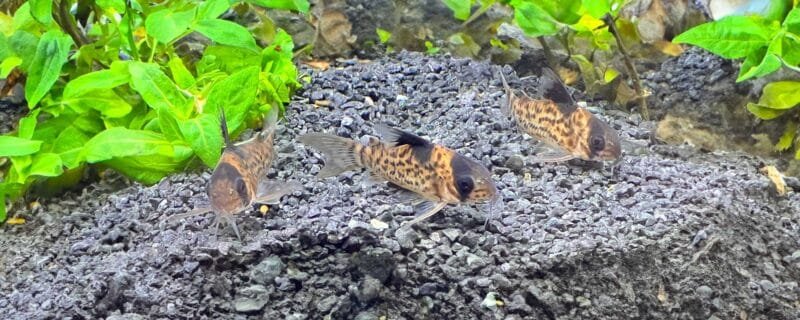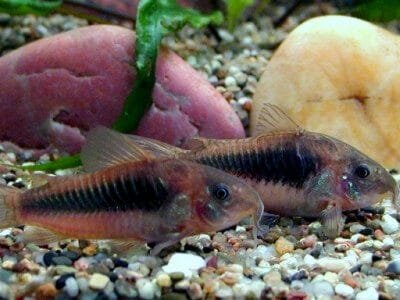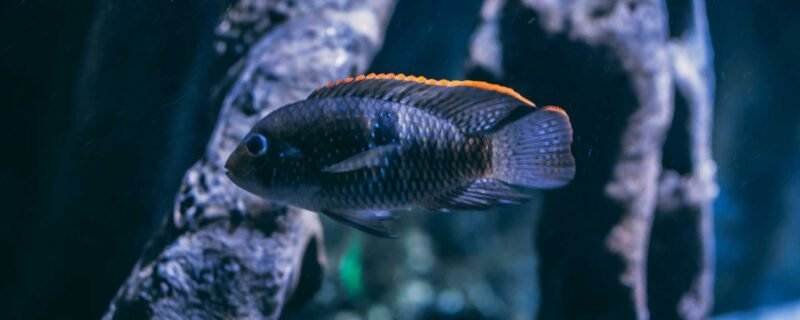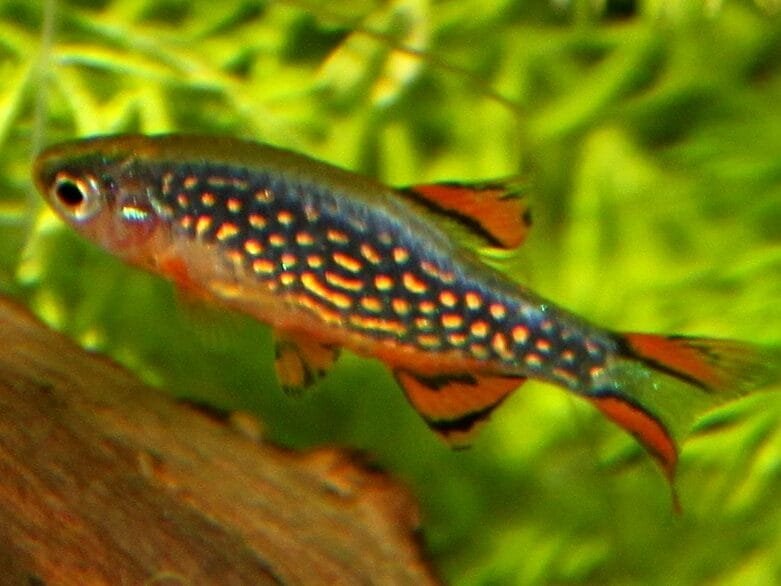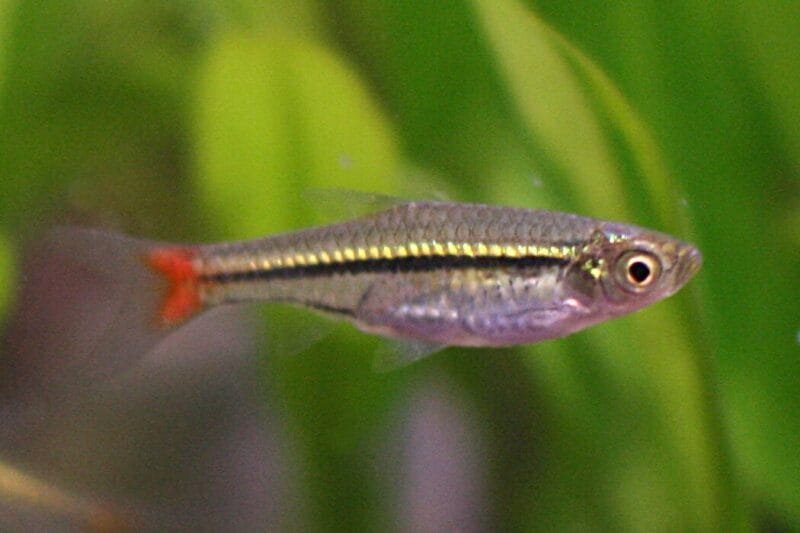The False Bandit Corydoras, scientifically known as Corydoras melini, is a delightful and active freshwater catfish species belonging to the Callichthyidae family. Often confused with its close relative, the Corydoras duplicareus (the true Bandit Corydoras), the False Bandit is prized for its charming mask-like facial stripe and gentle temperament. These small bottom-dwelling fish are excellent additions to community tanks and are well-loved by aquarists for their social behavior and ability to keep the substrate clean.
Native Habitat and Origins
Corydoras melini is native to the upper Rio Negro and Rio Uaupés river basins in Brazil and Colombia, part of the vast Amazon River system. In the wild, they inhabit slow-moving tributaries and streams with soft, sandy bottoms, leaf litter, and dimly lit waters shaded by dense vegetation. These natural conditions provide plenty of hiding spaces and microfauna for feeding. Mimicking this environment in the home aquarium helps bring out their best colors and natural behaviors.
Physical Description and Size
The False Bandit Corydoras has a distinctive appearance marked by:
-
A creamy beige to silvery body
-
A bold black band running diagonally from the top of the head through the eye (resembling a bandit mask)
-
Another black stripe running from the dorsal fin down to the base of the tail
They grow to about 5–6 cm (2–2.5 inches) in length, making them an ideal size for community tanks. Their body is covered in bony plates called scutes, a hallmark of all Corydoras species, offering protection and structure.
Diet and Feeding
Corydoras melini are omnivorous bottom feeders that will accept a wide range of foods. In the wild, they forage constantly for small crustaceans, insect larvae, and plant debris. In the aquarium, they thrive on a balanced diet that includes:
-
High-quality sinking pellets or wafers (formulated for catfish or bottom feeders)
-
Frozen or live foods such as bloodworms, daphnia, or brine shrimp
-
Blanched vegetables (like zucchini or spinach) offered occasionally
-
Occasional treats of micro worms or tubifex
Feeding them in the evening or just before lights out ensures they get their share of food before other, faster tank mates consume it.
Sexing and Breeding
Sexing
Mature female False Bandit Corydoras tend to be larger and rounder-bodied, especially when carrying eggs. Males are usually slimmer and slightly shorter, with a more streamlined shape.
Breeding
Breeding Corydoras melini follows the typical Corydoras spawning pattern. When in good condition and provided with a clean, well-maintained environment, they will often spawn naturally.
Breeding setup tips:
-
Use a separate breeding tank with soft, slightly acidic water (pH around 6.5–7.0).
-
Maintain the temperature at 24–26°C (75–79°F).
-
Provide fine-leaved plants or spawning mops for egg laying.
-
Condition adults with live or frozen foods.
-
Simulate rainfall by performing cooler water changes to trigger spawning.
After spawning, the adults should be removed, as they may eat the eggs. The eggs hatch in about 3–5 days, and fry can be fed infusoria or baby brine shrimp once they become free-swimming.
Water Conditions
To maintain the health and activity of your False Bandit Corydoras, the following parameters are recommended:
-
Temperature: 22–26°C (72–79°F)
-
pH: 6.0–7.5
-
Hardness: 2–12 dGH
-
Tank Size: Minimum of 20 gallons for a small group
Keep in mind that Corydoras are social fish and must be kept in groups of at least 6 or more. They become shy and stressed when kept alone.
Ease of Care
Corydoras melini is easy to care for, making it suitable for beginners and experienced aquarists alike. Their peaceful temperament, small size, and hardy nature make them adaptable to most well-maintained freshwater tanks. However, they are sensitive to poor water quality, so regular partial water changes and a clean substrate are essential. Avoid sharp gravel or decorations that could injure their delicate barbels.
Compatibility and Tank Mates
The False Bandit Corydoras is a peaceful community fish that gets along with a wide range of tank mates. They rarely show aggression and prefer calm company.
Ideal tank mates include:
-
Other Corydoras species
-
Small tetras (e.g., neon, ember, or rummy-nose tetras)
-
Dwarf gouramis
-
Livebearers (like guppies or mollies)
-
Shrimp and snails (peaceful invertebrates)
Avoid keeping them with large, aggressive fish such as cichlids or predatory species, as these can stress or harm them.
Species Variations and Similar Relatives
Corydoras melini is often compared to the Corydoras duplicareus, which has a similar bandit-like appearance but can be distinguished by a broader black stripe and different dorsal patterning. Both species share similar care needs and behavior.
There are also albino variations of related Corydoras species, such as Albino Corydoras aeneus, but no true albino form of Corydoras melini exists in the aquarium trade at this time. However, the albino Corys share many of the same care characteristics and are just as social and hardy.
Community Tank Role
False Bandit Corydoras are bottom dwellers that constantly sift through the substrate, helping to keep it clean by eating leftover food. They are best viewed as active cleaners and social companions, not as janitors. Their playful group dynamics add life and movement to the lower levels of the aquarium.
Key Takeaways
-
Scientific Name: Corydoras melini
-
Common Name: False Bandit Corydoras
-
Origin: Brazil and Colombia (upper Rio Negro, Rio Uaupés)
-
Size: 5–6 cm (2–2.5 inches)
-
Diet: Omnivore; bottom feeder
-
Temperament: Peaceful and social
-
Tank Level: Bottom
-
Ease of Care: Easy
-
Breeding: Egg layer; spawns readily in ideal conditions
-
Tank Mates: Peaceful small community species
Frequently Asked Questions (FAQs)
1. How many False Bandit Corydoras should I keep together?
Corydoras melini are shoaling fish and thrive in groups of at least six or more. Keeping them in groups encourages natural behavior and reduces stress.
2. Can Corydoras melini live with shrimp?
Yes, they can! False Bandit Corydoras are peaceful and will not harm adult shrimp. However, they may eat very small shrimp fry if given the opportunity.
3. What substrate is best for Corydoras melini?
A soft sand substrate is ideal. It protects their barbels while allowing them to forage naturally. Avoid coarse or sharp gravel that could damage their sensitive mouths.
Conclusion
In summary, the False Bandit Corydoras (Corydoras melini) is an elegant, peaceful, and easy-to-care-for species that thrives in groups within a calm, well-maintained aquarium. With their distinctive markings and social nature, they’re perfect for aquarists seeking an engaging bottom-dwelling fish that contributes both beauty and balance to a freshwater community tank.

